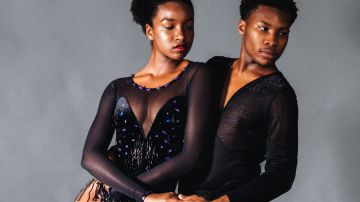14 Latinx and Hispanic Dance Crazes Through the Ages
Dance is an integral part of any culture, and the Latinx culture is no different

Photo: Unsplash
Dance is an integral part of any culture, and the Latinx culture is no different. There are traditional, folkloric dances that have been around for centuries; and those that that blew up as crazes, continuing to become essential and timeless, like salsa, and tango. Then there are the dances of the moment, the crazes and fads that come and go, but are so much fun to get down to.
Since we all have so much extra time on our hands these days, why not add some fun, and Latinx pop culture to your schedule and learn some of these cool Latinx dances? We are sharing some history on each, along with easy-to-follow videos that will have you moving in no time. Added bonus? They’re great as alternative workouts!
wp_*posts
Rumba
The rumba is a mix of Afro-Cuban sounds and European ballroom dance, emerging from America’s East Coast. It became a craze during the 1930s, and is still danced by ballroom dancers today. This version is also known as “ballroom rumba,” and “rhumba,” to differentiate it from Cuba’s rumba music and dance.
wp_*posts
Mambo
https://www.youtube.com/watch?v=Oqc1bAwMsrU
Another dance craze that emerged from Cuban music is the mambo. It was created in Cuba during the 1940s, and made popular in the U.S. and Mexico by Perez Prado. It is related to Cuban danzón, and is different than the more modern New York mambo also called “salsa on 2.”
wp_*posts
Conga
No, this isn’t the conga of Gloria Estefan fame, but rather the old school dance that became popular during the 1930s and ’50s. It comes from the Afro-Cuban conga music, said to be named for the Congolese slaves who came to Cuba from the Republic of Congo. The timeless dance is made up of a 1-2-3-kick move and is traditionally danced during carnival.
wp_*posts
Cha-Cha-Cha
Another timeless Latinx dance that was a craze during the 1960s is the cha-cha-cha. Like many other vintage Latinx dances, the cha-cha-cha originated in Cuba, from cha-cha-cha music, created by Enrique Jorrin. The moniker of cha-cha-cha comes from the shuffling sound made by the dancers’ triple step.
wp_*posts
Bossa Nova
The samba dance is an Afro-Brazilian (from Congo and Angola) creation that blew up as a dance fad during the 1960s. Samba danced at Carnaval is danced solo, but other versions of samba, like ballroom samba, and samba de Gafiera is danced with a partner.
wp_*posts
Lambada
Another dance from Brazil is the lambada, nicknamed “The Forbidden Dance.” It became a dance craze during the 1980s, due to the song, released in the late ’80s, and the 1990 American film (“Lambada: The Forbidden Dance”).
wp_*posts
El Baile Del Perrito
A true dance fad that had a moment in 1989 was el baile del perrito. Proving that a song with a dance often leads to a hit, Afro-Domincan Wilfredo Vargas’ “El Baile del Perrito” was a merengue jam accompanied by easy-to-copy moves that everyone did on the dancefloor.
wp_*posts
Quebradita
Our next Latinx dance craze takes us to Mexico (specifically Sinaloa and Jalisco) and U.S. cities near the U.S.-Mexico border. La quebradita, which translates to “little break” is an acrobatic partner dance that is danced to a faster-paced cumbia accompanied by banda instruments.
wp_*posts
Macarena
There were a few dance crazes in the U.S. which originated from Spain. One that you probably remember from 1993 is the macarena. From the Los del Rio song of the same name. The macarena features a whole lot of hand movements and some hip-shaking that proved to be popular at quinces and other Latinx parties everywhere.
wp_*posts
Asereje (The Ketchup Song)
Another Spanish dance fad is the one that went along with “Aserje (The Ketchup Song),” by the girl group Las Ketchup. Like the macarena, The Ketchup Song dance has a lot of hand movements, a fun, silly feel, and is brimming with ’90s nostalgia.
wp_*posts
Lean Back
Not all dance crazes have to be ornate, with a bunch of steps you have to learn. In 2004, Fat Joe and the rest of the Terror Squad had the world leaning back with their hit song, “Lean Back.” The dance was just as simple and direct as the jam’s title–all you do is lean back, or “do the rockaway.” Because “gangsters don’t dance,” they “boogie.”
wp_*posts
Duranguense
Duranguense, and its dance, the pasito Duranguense, comes from Chicago Mexicans from Durango. The musical movement started in Chicago thanks to the group Montez de Durango. Like la quebradita, el pasito Duraguense is danced in traditional Western wear.
wp_*postsSalsa Choke/Chichoke
Remember during the 2014 World Cup, when the Colombia team would dance as a group after making a goal? They were dancing salsa choke. Originating in Tumaco in 2004 (some sources say 2008) and brought to Cali, salsa choke is a blend of salsa, African, electronica, and house music sounds. The corresponding dance has been described as a bachata step, but much faster.
wp_*posts
Champeta
Shakira made sure to include some champeta in her major Super Bowl Halftime Show performance and create the Shakira champeta challenge. The Afro-Colombian (links to Congo and Nigeria) dance comes from Cartagena, where it has been a thing since the 1970s, but has recently resurged as a dance craze. There is also a new genre of champeta music called champeta urbana.

















